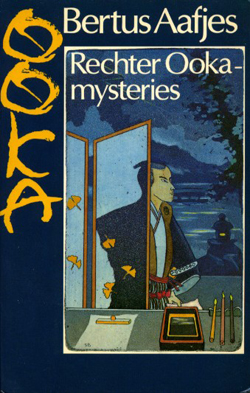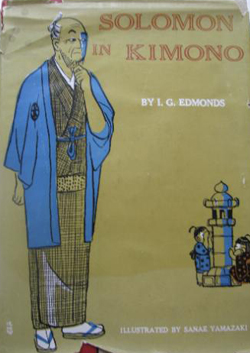
“A Touch of Dutch” article, there is quite a bit. It’s just that I try to focus mainly on Japanese crime fiction. However, I had to make an exception for Bertus Aafjes’ Judge Ooka series. A Dutch series set in Japan about a historical Japanese judge? I was sold!
Ooka Tadasuke (1677-1752), also known as Ooka Echizen, was a samurai during the reign of the Tokugawa shogunate. He served as the magistrate of the city of Edo, nowadays known as Tokyo. Ooka showed himself to be an exceptional man in many ways. For example, he established the first fire brigade made up of commoners in Edo as well as a city hospital. But Ooka was especially known for his wisdom. As the highest authority in Edo, he was chief of police, judge and jury combined. In the movies, a person wielding so much power would definitely go over to the dark side, but as I said, Ooka was an exceptional man.
Ooka is especially known for his very unorthodox legal decisions. Similar to the biblical Solomon, Ooka was able to come up with satisfying solutions to seemingly impossible problems. For example, in one case an innkeeper tried to sue to somebody for stealing the smell of the food he cooked. Ooka in all his wisdom came up with a solution almost as ridiculous. The defendant was to pass money from one hand to his other: the sound the money made as they passed from hand to hand was to be the payment: the sound of money for the smell of food.

Dutch writer/poet Bertus Aafjes came across Edmonds’ Solomon in Kimono: Tales of Ooka, a Wise Judge of Old Yedo during one of his travels to Japan. Impressed by the tales, Aafjes decided to write his own original Ooka stories. His first book, the short story collection A Ladder Against a Cloud (Een Ladder Tegen Een Wolk, 1969) is quite interesting: it is full of little legal problems that seem impossible to solve at first sight, but Ooka somehow manages to present a solution satisfactory to all. Well, except for criminals maybe. Aafjes’ writing talent also comes to life in these stories, which have a sentimental, romantic touch to them. The series was reasonably popular, and Aafjes penned a total of five Judge Ooka novels:
- Een ladder tegen een wolk (A Ladder Against a Cloud; 1969)
- De rechter onder de magnolia (The Judge Beneath the Magnolia Tree; 1969)
- De koelte van een pauwenveer (The Coolness of a Peacock Feather; 1971)
- De vertrapte pioenroos (The Trampled Peony; 1973)
- Een lampion voor een blinde (A Lantern for the Blind; 1973)
While the stories are certainly amusing, reminiscent of the Judge Dee stories by Van Gulik (who was also Dutch), Aafjes’ Judge Ooka novels have sadly never been translated. So for the time being, learning Dutch is the only way to read these novels. Unless some publisher suddenly shows Ookanian wisdom in tackling this problem and publishes a translated version of these wonderful little stories!

A few months ago, someone left a comment on my review of [url=http://moonlight-detective.blogspot.com/2011/06/solomon-in-kimono.html]The Trampled Peony[/url] noting that there are German translations
available of this series, and after digging around I uncovered the following titles: Richter Ookas fälle and Der tiebstahl im teehaus. The former is a translation of Een ladder tegen een wolk and the latter is probably a translation of De vertrapte pioenroos, but there’s also the possibility that it’s a compilation of stories culled from the pages of all four collections.
By the way, I’ve always been fascinated at how many of our compatriots penned detective stories set in (historical) Asia. Aafjes, Van Gulik, Van de Wetering and not so long ago I stumbled over an obscure, rarely mentioned writer from the 1940s whose mysteries took place against the backdrop of Dutch-Indonesia.
It’s not strange to see these particular people writing detective fiction set in Asia, considering their backgrounds (Van Gulik being a Sinologist; Van de Wetering having spent a lot of time in Asia and well, Dutch East Indies speaks for itself, I guess.
The question is more ‘why this particular group’ and not, for example, a group of Dutch writers with a background in the Middle-East writing detective fiction set in the Middle-East.
(Which might exist, of course. Haven’t done research on that)
Well, the Dutch-Indonesian writer I referred to, C.W. Wormser a.k.a. “Boekan Saja,” lived and worked on different posts in Indonesia, and poured these experiences into four detective novels – which apparently strongly evoke the atmosphere of the time and setting. So that’s one with a background in the Middle-East, but who knows how many more writers like him were lost in the mists of time.
But I am going to look into Wormser/Saja first as I have Het geheim van de tempelruïne laying around here and will probably read it later this month.